Sold-out performance
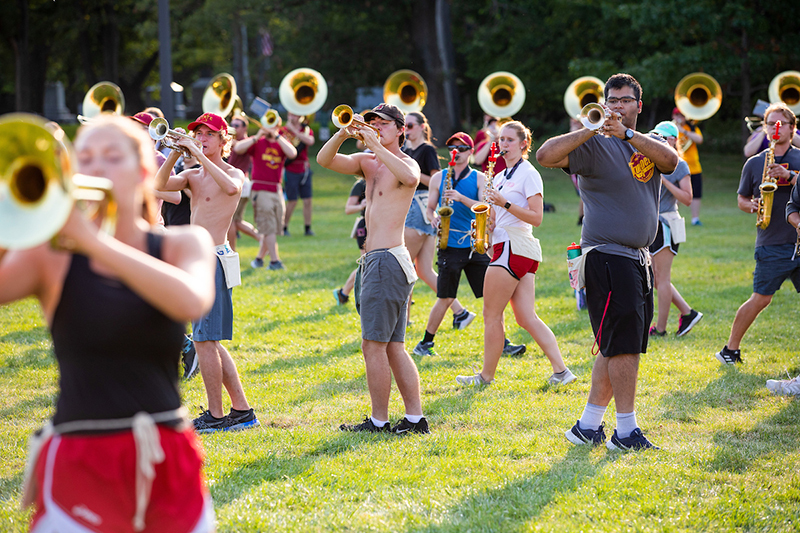
Cyclone Marching Band members practice Monday evening for their Sept. 4 season debut. Photos by Christopher Gannon.
The first home football game of the season on Saturday also means Game Day for the 400-plus members of the ISU Cyclone Marching Band, pictured Monday at their practice field west of the Communications Building. With the athletics department announcing a sold-out stadium for the first two weekends of the season, the band will be performing a "summer pop hits" theme for more than 60,000 fans Saturday at Jack Trice Stadium. The band includes 355 marchers and another 62 student musicians who add sound in the stands.
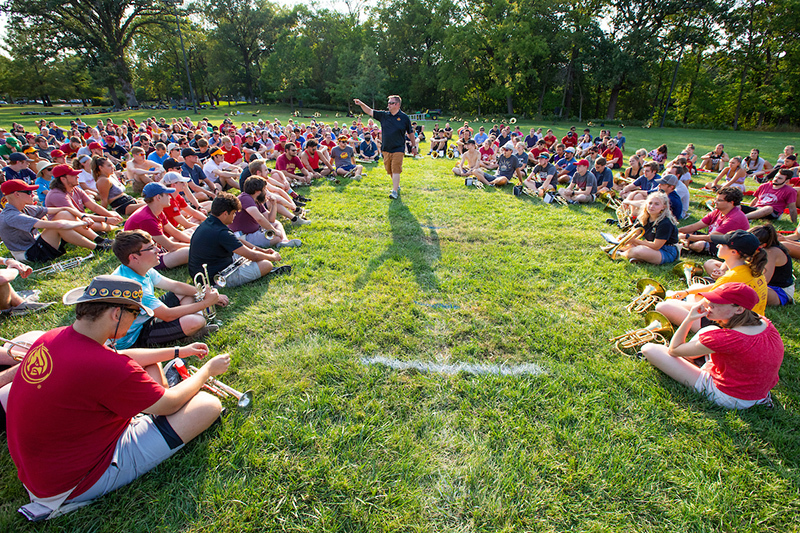
Christian Carichner, director of the Cyclone Marching Band, shares instructions during a break in Monday evening's rehearsal.
Campus, county and state COVID-19 data is available online
Iowa State has a new online source for campus COVID-19 test results as well as county- and state-level data provided by the Iowa Department of Public Health and the Centers for Disease Control and Prevention.
The COVID-19: By the Numbers website includes the following campus data for the prior week:
- Positive results for symptomatic students tested at Thielen Student Health Center (TSHC)
- Total symptomatic tests conducted at TSHC
- Positivity rate for the prior week
- Total vaccine doses administered on campus
Iowa State's public health team will update the page every Wednesday. The page can be accessed from the COVID-19: Moving Forward website.
The campus data will look different from the data provided last spring and fall. Erin Baldwin, associate vice president for student health and wellness and director of Thielen Student Health Center, says the differences reflect changes to the university's public health infrastructure and testing strategies.
"The university's testing strategy this fall is focused on symptomatic students. As a result, we expect to see higher positivity rates at different points throughout the semester," Baldwin said. "This also means the primary campus data we have available is symptomatic testing for students at Thielen Student Health Center."
As the COVID pandemic has shifted, Iowa Department of Public Health guidance has transitioned to reduced case investigation and contact tracing. Accordingly, Iowa State is no longer providing case management and contact tracing or requiring all students, faculty and staff to self-report COVID-19 positive test results from off-campus sources. These processes provided additional sources of data that are no longer available.
Baldwin and Kristen Obbink, who continues to serve on the public health team after transitioning out of her full-time role as the university's COVID-19 public health coordinator, say it's important to look at the campus numbers along with the data from state and federal sources, which are available on the webpage. With the high level of transmission in Iowa and the likelihood of COVID-19 becoming an endemic, Obbink recommends getting the vaccine and wearing a mask to protect your health and others.
"As COVID-19 is shifting from a pandemic to an endemic, this means we'll never completely eradicate the virus," Obbink said. "With that in mind, we need to work on building immunity and the vaccine is the best tool we have to do that and limit the spread of the virus."
Testing options on campus
At-home COVID-19 test kits are widely available in the community and state. Students, faculty and staff can pick up a free test kit at the following locations:
- Thielen Student Health Center: front desk, 8 a.m.-5 p.m. weekdays except Wednesdays (9 a.m.-5 p.m.)
- Memorial Union: information desk, second floor near Cardinal Room, staffed all MU hours
- Union Drive Community Center: mailroom, across from Clyde's, 8 a.m.-6 p.m. Monday-Friday, Saturdays 1-5 p.m.
- College of Veterinary Medicine: room 2270, office of academic and student affairs, 8 a.m.-5 p.m.
More information about at-home testing is available from the Thielen Student Health Center, including nearby UPS sites for dropping off completed kits.
On-campus testing is available for symptomatic students through Thielen Student Health Center. McFarland Clinic also has testing options available.
Supplies reminder
Campus units are strongly encouraged to order cleaning supplies, hand sanitizer and face coverings through Central Stores. While employees may find what they need online or from a local retailer, everyone benefits from purchasing centrally through:
- Power in numbers: Central Stores works closely with its vendors and can negotiate a better price by buying in bulk.
- Avoid scams: Demand is creating opportunity for scammers selling fake items or not fulfilling orders. The university has seen an increase in fraud, which can be avoided by working with Central Stores.
- Get the proper products: Environmental Health and Safety worked with Central Stores to ensure that the cleaning supplies offered are safe and effective for cleaning offices and labs. It's not necessary to buy name-brand products, and soap and water is a good alternative.
Gelato shop with a 'wow' factor opens in MU
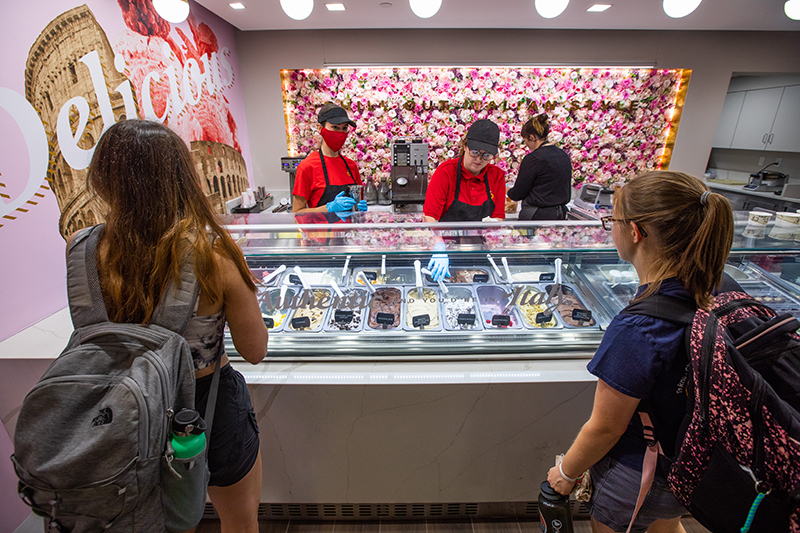
Customers consider their orders at Dolce Freddo, the gelato shop ISU Dining opened in the Memorial Union this month. Photos by Christopher Gannon.
In its first week of operation, traffic surged on Friday afternoon at Dolce Freddo, ISU Dining's newest Memorial Union eatery. That made sense to Amanda Wever, assistant manager of both Dolce Freddo and the production facility for the gelato and sorbet it serves.
With its striking back wall covered in white and pink silk roses and a menu of rotating flavors and novel creations -- a plate of gelato "nachos," for instance -- Dolce Freddo was designed to be fun and a bit exotic, an appealing prospect as Friday is about to become the weekend.
"It definitely has a 'wow' factor. It's almost like you're on vacation," Wever said.
ISU Dining began making gelato and sorbet in 2019, serving it at the Hub. It was a good fit with The Roasterie's coffee and espresso, an authentic and on-trend offering that features fresh ingredients and the flexibility to try new flavors, said Jamie Lenz, senior associate director of ISU Dining. As pre-pandemic sales climbed at the Hub, ISU Dining decided to open a standalone gelato shop in an open storefront on the MU's first floor just east of Panda Express.
The store's Italian name, pronounced "dole-chay freh-dough," drives home the authenticity of the product and roughly translates as "sweet cold," Lenz said. The aim with the look of Dolce Freddo is to maximize the impact of a small space and make it feel like somewhere else.
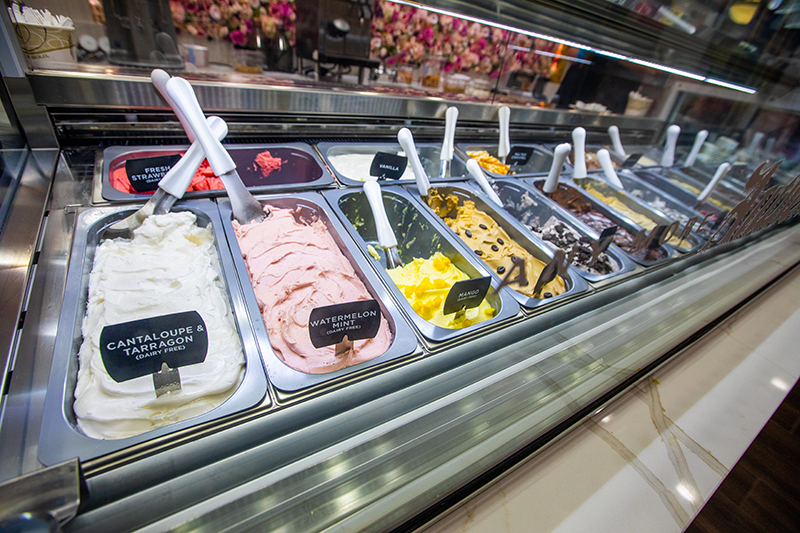
The rotating lineup of 16 flavors at Dolce Freddo always features fresh ingredients and some dairy-free sorbet options.
"The flower wall is key to the design because it faces the hallway and is so unexpected when you walk by. Our goal is that it draws you in to try the product," he said.
Dolce Freddo opened the first day of classes. Earlier this week, freshman Robert Polidoro stopped by for his first taste. He grew up in an Italian family in the Bronx, a useful background for judging gelato.
"It does not disappoint," he said after trying the stracciatella, which is vanilla with thin shards of chocolate. "This place carves out a very good niche."
The 16 flavors offered daily include some core stalwarts – like cookies and cream, which Wever said is the No. 1 seller – and an ever-changing lineup of limited runs and new concoctions, such as the pumpkin pecan debuting soon. The menu always has a handful of sorbets, a dairy-free option. This week, one of the sorbets was cantaloupe-taragon featuring melon grown at the ISU Horticulture Research Station north of Ames, Wever said. See Dolce Freddo's online menu to view the current flavors.
The menu also features shakes, popsicles and specialty products such as a panini, nachos and spaghetti, all made from gelato. The "chips" for the nachos are waffle cone pieces. The "spaghetti" is made from vanilla gelato shaped like noodles with a potato ricer, topped with strawberry sauce for marinara, toasted coconut flakes for parmesan and optional balls of chocolate gelato as meatballs.
While she appreciates the indulgent novelties, Dolce Freddo regular Millicent Cameron also likes that the products are lighter than other frozen desserts, and the sorbet makes it convenient to enjoy a treat with her lactose intolerant sister. And she loves the shop's design.
"It's super fancy and modern," said Cameron, ISU catering assistant manager.
For now, Dolce Freddo is open 10:30 a.m.-3 p.m., hours limited by hiring challenges. If staffing allows, Lenz hopes weekday hours will extend to 6 or 7 p.m. eventually, with occasional pop-up openings on weekends and later in the evening.
Teaching faculty and staff with a COVID-19 diagnosis have options
Instructors who test positive for COVID-19 this fall and feel well enough to teach may move their courses online during the required isolation period, senior vice president and provost Jonathan Wickert announced in a Sept. 1 message to department chairs.
Based on Centers for Disease Control and Prevention guidelines, instructors who contract COVID-19 are expected to isolate at home until 10 days after their positive test if asymptomatic and 10 days after the first sign of symptoms, if they experience any. In addition, those with symptoms should continue to isolate until they've been fever-free for at least 24 hours and are seeing other COVID-19 symptoms improve.
During the isolation period, instructors who are willing and able may continue teaching by changing the delivery mode of their in-person courses to synchronous online. Department leaders should tell students about the temporary change as soon as possible, and Wickert's message provided a template for student notification.
Instructors who test positive should provide the test results to their human resources delivery team, which can be contacted by email at hr_delivery@iastate.edu. HR delivery specialists will review and approve the documentation. Instructors shouldn't send test results to their department chairs.
If an instructor with COVID-19 is too ill to teach online during their isolation, they should follow the usual process for medical absences and use accrued sick time or the additional bank of COVID-19 sick time provided by the state Board of Regents for fiscal year 2022. Departmental leaders will arrange to cover the courses, with a preference for maintaining in-person delivery.
Some COVID-induced shifts in learning have staying power
Student accessibility services (SAS) assists about 2,000 students each year, providing accommodations for those with disabilities or temporary health conditions.
That work was put to the test during the pandemic as SAS developed new or modified ways to help students learning in an online or hybrid environment.
Those challenges taught lessons and brought technological advances that will continue benefiting students, even as they return to the classroom.
Adapting
The move online had many instructors recording their lessons so students could watch when it was convenient. It helped students who had a schedule conflict and lessened the impact of missing class.
Presentation
Jamie Niman and Lori Mickle will present on the flexibility of universal design for learning on Oct. 26 (11:15 a.m., 2030 Morrill) as part of Disability Awareness Week.
"That is an example of a universal design platform we are hoping will continue," said Lori Mickle, instructional technology specialist in the Center for Excellence in Learning and Teaching.
Universal design makes the environment usable by all people without adaptation or specialization.
SAS accessibility coordinator Jamie Niman said some students with attention deficit hyperactivity disorder found online delivery enhanced their learning.
"They said it was optimal for them because the classroom can be very distracting, and they can control their environment at home," she said. "They could make it very quiet. They could move around as they learned."
Everyone's needs are individualized. Some flourished online while others needed the classroom structure and requested to come to class when safety measures allowed, Niman said.
Instructors also got creative testing students' knowledge. Finding ways to assess learning besides exams allowed some students to shine. Whether it was presentations, group projects or writing, students have different ways of sharing their knowledge, Mickle said.
Meetings between SAS staff and students also enjoyed improved attendance with a virtual option.
"We offered focus sessions, which were two-hour blocks of time where students could log into WebEx, and the soft-skills coach would check in with them after establishing their goals," Niman said.
The coach would check in halfway through and at the end of the session. It made completing a task easier and didn't require students to travel across campus for support. Niman said virtual options like focus sessions are important because SAS space limitations do not allow large numbers of students to gather in-person.
Captioning
Captioning lectures for deaf and hard-of-hearing students became a significant issue for Zoom and WebEx instruction beginning in March 2020. Niman said coordinating captioners required adding them to Zoom or WebEx sessions, and instructors were asked to help coordinate.
Previously, a faculty member wore a microphone that sent audio to a captioner working remotely to be put into a document for a student. That changed with the move online. Students interacting with breakout groups or shifting between small- and large-group discussions was more common.
"When everything went online the captioner had to be integrated into the chatroom or somehow get the audio," Mickle said. "It was trying to figure out how to get non-ISU members to where they needed to be."
Niman said advances made by videoconferencing services since the start of the pandemic have improved numerous functions, including closed captioning.
Canvas
Moving classes online introduced challenges finding homework assignments, guidelines to complete work and expectations in Canvas. As faculty became more comfortable and knowledgeable, consistency in Canvas navigation improved for students, Niman said. Instructors and students also became more familiar with what the learning management system could offer to assist faculty delivery and enhance communication.
Crowdfunding site supports central campus plaza
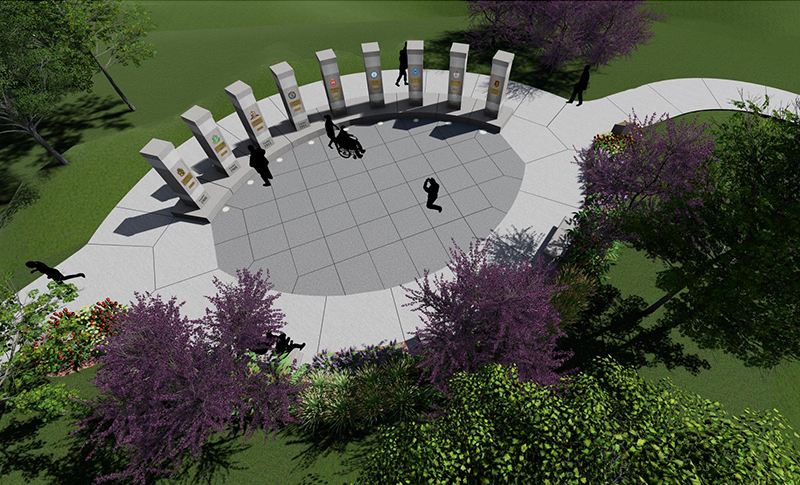
Sketch of the under-construction National Pan-Hellenic Council plaza on the Memorial Union lawn.
On the northwest lawn of the Memorial Union, poured foundations await nine columns at a plaza that will promote the historically Black fraternities and sororities of the National Pan-Hellenic Council (NPHC). On the current timeline, the plaza should be completed by Dec. 1.
Not to be confused with a similarly named umbrella organization for women's sororities (National Panhellenic Conference), the NPHC supports and promotes collaboration among chapters of nine African-American Greek-letter sororities and fraternities. Eight of the nine have chapters at Iowa State, and conversations with the ninth are in progress, said Billy Boulden, assistant dean of students and director of sorority and fraternity engagement.
He said the plaza is about representation and about creating a more welcoming and inclusive campus. He compared it to the large sorority and fraternity homes south of campus, many purchased by their alumni, and the "presence" they provide their organizations and student members.
"The work doesn't end with a plaza. There's a lot more work we can do to create equity and representation, but this is a step in the process," Boulden said.
The completed plaza will be a gathering spot, an events and celebrations place and a space for personal reflection, he said. The expectation is that those who use it will respect what it represents. Its prominent location on central campus will make it visible to many visitors and send a message, particularly to prospective students, that Black lives matter at Iowa State, he said.
Boulden said the plaza also is designed to teach. Each of the pillars will contain information about that organization's letters, purpose and ISU chapter charter date. At the two sidewalk entries to the plaza, visitors can read about the NPHC's history and purpose and the council's history at Iowa State.
The NPHC has a long history at Iowa State, he said, a story that's rarely shared. For example, two of the university's most famous Black students, George Washington Carver and Jack Trice, were members of NPHC fraternities Phi Beta Sigma and Alpha Phi Alpha, respectively. Iowa State chapters for two others, Delta Sigma Theta Sorority and Kappa Alpha Psi Fraternity, are single letter chapters -- among each group's earliest.
You can support the plaza
As construction progresses this fall, anyone can contribute to the plaza project through FundISU, the Iowa State University Foundation's crowdfunding tool. Visit www.fundisu.com, locate the plaza project and click on "Make a Gift."
Dana Savagian, the foundation's associate director for annual and special gifts, said donors may opt to honor one of the nine sorority or fraternity organizations or give to the overall project. Either way, all gifts go to the same fund, she said. Giving options include one-time online, check by mail, recurring monthly gift and payroll deduction for university employees.
The crowdfunding site will close later this fall, though the NPHC plaza fund will remain open for gifts.
The student affairs division provided seed money to launch the project. The goal is to cover most of the estimated $400,000 cost with private gifts.
What is the National Pan-Hellenic Council?
The NPHC was founded in 1930 at Howard University, Washington, D.C., with five charter organizations:
- Alpha Kappa Alpha Sorority
- Delta Sigma Theta Sorority
- Zeta Phi Beta Sorority
- Kappa Alpha Psi Fraternity
- Omega Psi Phi Fraternity
Since then, the council added four organizations:
- Alpha Phi Alpha Fraternity (1931)
- Phi Beta Sigma Fraternity (1931)
- Sigma Gamma Rho Sorority (1937)
- Iota Phi Theta Fraternity (1997)
All but Iota Phi Theta have a chapter at Iowa State.
Plaza history
Boulden said a national network of outdoor NPHC plazas on university campuses "give space back" to students of color, a response to a time in this country when Blacks couldn't own property.
The idea for one at Iowa State was simmering when Boulden arrived in 2013. He said student government president Julian Neely (2018-19), also an Alpha Phi Alpha fraternity member, advanced the project significantly, including a campus tour with facilities staff to scout prospective sites.
Former and current leaders in student affairs also are NPHC sorority or fraternity members, including Tom Hill, Martino Harmon, Vernon Hurte, Pamela Anthony, Sharron Evans and Toyia Younger, which helped maintain momentum for the project, Boulden said.
Blue or green? It matters.
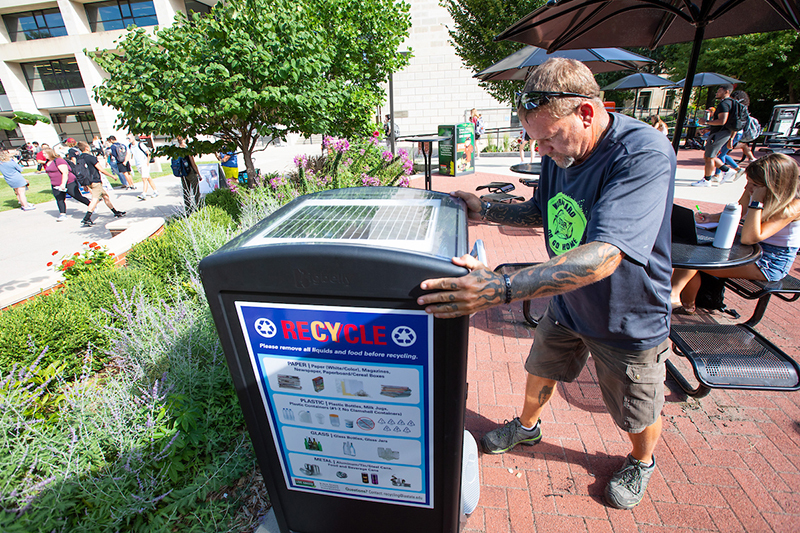
FP&M employee Shadow Alitz installed one of the new solar-powered recycling compactors outside the Hub last week. One of six with the foot pedal open option and informational signage, it joins nine compactors around campus designated for recycling paper, plastic, glass and metal. Visible in the background is a green solar-powered trash compactor. Photo by Christopher Gannon.
With funding last year from student government for six more solar-powered recycling compactors, recycling coordinator Ayo Oluwalana in facilities planning and management grabbed a chance to clean up the campus community's recycling of paper, metal, plastic and glass when they're on the go.
From campus services staff who empty the green trash compactors and blue recycling containers, he knows contamination -- trash landing in recycling containers or vice versa-- is a problem. So Oluwalana, in partnership with the office of sustainability, designed "show me" signage that contains images of all the materials that belong in a blue recycling compactor. The six new recycling stations, also notable by their hands-free foot pedal that opens the hopper door, have the new signs, and Oluwalana will test whether different labeling helps members of the campus community distinguish between trash and recycling receptacles.
The green trash compactors also outnumber blue recycling containers on campus about 8:1, making it impossible to pair the two in every location. Even in locations where they sit side by side, users often don't detect the difference, he said.
"When someone takes a split-second decision to decide which container to use, I think an image of what should go inside is important," he said.
So the six new recycling containers intentionally were paired with a green trash compactor in high-traffic locations.
Every couple of months throughout this academic year, in collaboration with campus services and the Zero Waste Team, Oluwalana will compare recycling volume and contamination between stations with the old and new signage.
"We'll see if people are getting the message; if the sign gives clarity about recycling, and if pairing the trash and recycling containers prompts people to use them correctly," he said.
Where are they?
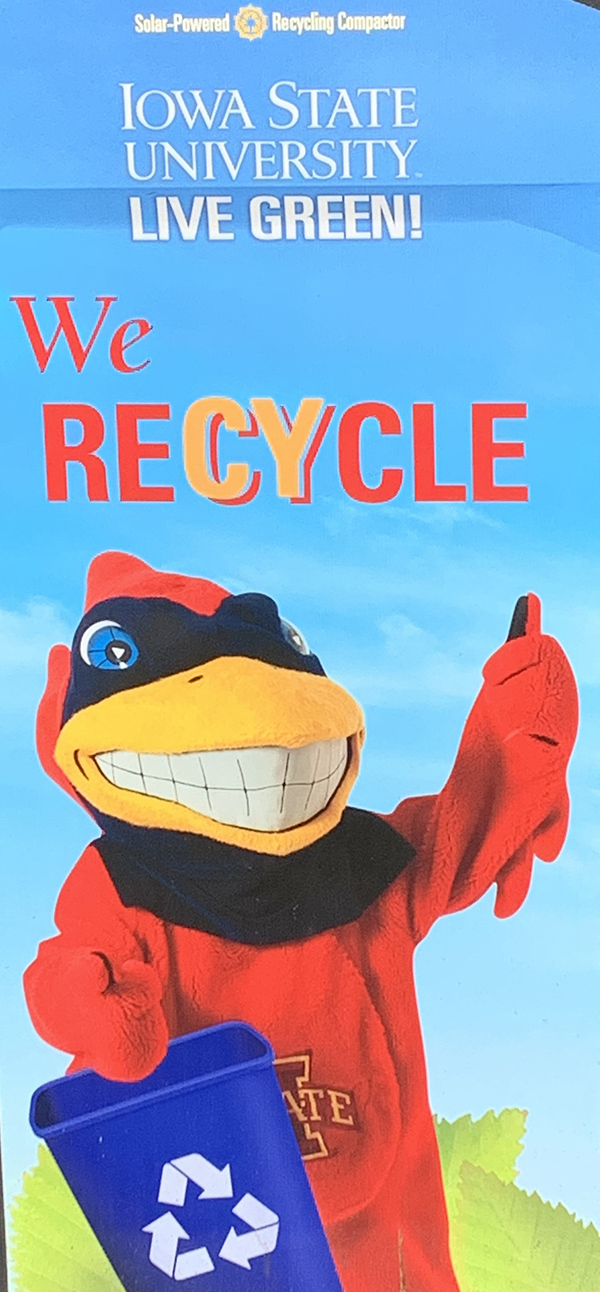
First recycling wrap
- Campus services teams installed the new containers in busy locations: Northwest sidewalk of the Memorial Union; and near Kildee, Curtiss and Beardshear halls, the Hub and the transit hub at the Iowa State Center.
- The nine containers with the original recycling wrap (right) are near Beyer, Pearson and Troxel halls, Student Innovation Center, Biorenewables Laboratory, the northeast corner of Lake Laverne, east campus parking deck, Lied recreation center and the fish tank lobby entrance at the College of Veterinary Medicine campus.
Strolls program promotes wellbeing and campus sites
Strolls for Well-Being at ISU helps people center themselves during their day while they learn more about campus. The new program is a joint effort of staff in ISU WellBeing and the Center for Excellence in Learning and Teaching (CELT).
"It is a way to connect employees, students and anyone in the community with our beautiful campus in a mindful and intentional way," ISU WellBeing specialist Sue Tew-Warming said.
Tew-Warming was inspired by the Morikami Stroll for Well-Being Therapeutic Garden Walking Program, a garden walking program in Florida.
What is a stroll?
What separates strolls from other walking programs at the university is the emphasis on self-care and well-being, Tew-Warming said. It also can help faculty, staff and students reconnect with campus after the pandemic moved many away last year.
This fall there are three themes -- awareness, transition and connection -- following the same central campus path that can be downloaded from the ISU WellBeing website. The winter will have three new themes with a different path.
"We ultimately hope to have 12 themes throughout the calendar year, so every season will have a new stroll," CELT event coordinator Karen Couves said. "We will take walkers to different parts of campus."
A stroll designates places to pause and focus on being present in the moment, reflect on a quote or move with purpose. Participants also learn about points of interest across campus.
The fall stroll uses several sculptures as its pauses. There are plans to have recreation services help plan a route in the future.
"It is a great way for us to collaborate with different departments across campus and bring something useful to the whole campus community," Couves said.
Strolls take about 45 minutes to complete, but people decide if they do it all or a certain pause to best utilize their time. Tew-Warming and Couves conducted a pilot study this summer with faculty and staff trying a stroll to provide feedback.
"The biggest thing we heard was that flexibility is key," Tew-Warming said. "We want this to be flexible so it doesn't have to be done at 10 in the morning or two in the afternoon. It is for whenever people feel they have the time."
Couves also heard from instructors who plan to integrate a stroll into their courses to benefit themselves and their students.
Benefits
Practicing mindfulness regularly can have numerous benefits:
- Greater sense of calm
- Reduced stress level
- Stronger immune system
- Improved concentration
- Be less reactive in difficult situations
"Our modern offices are built for distraction," Couves said. "To support people's overall health and well-being, doing something like a pause is a really simple way to get back to the present moment, be mindful and get back into their day."
Ready to innovate? Here are some programs to check out.
Looking for some inspiration this fall? Check out the Student Innovation Center programming available to faculty and staff, a wide variety of presentations from industry leaders and ISU colleagues.
Professional practices
Once a month, the Student Innovation Center will hold its Innovation Professional Practice Series, with each session featuring ISU faculty, staff and graduate students discussing how to create and promote innovative behavior and cultural practices, said Karen Kerns, director of innovation programs.
Center on display
Experience "Interface," the new art in the Student Innovation Center's second-floor courtyard, at a free university museums reception Sept. 2 (5:30-7 p.m.). Created by artist Catherine Widgery, "Interface" is responsive to weather conditions, and twilight is an ideal viewing time. Tonight's event will include activities inspired by "Interface," along with pizza and refreshments. Online registration is preferred but not required.
On Sept. 30, a dedication ceremony for the Student Innovation Center will honor the public resources and generous donations that made the facility possible.
"In pockets of technical silos, we have a number of experts who conduct groundbreaking research in many areas of innovation. They're accelerating technical readiness and understanding and measuring student outcomes better. Their research provides insight into more compelling ways to learn and teach," Kerns said. "By un-siloing these cloisters of talent, we can scale and brand the innovation that occurs on our campus and beyond."
The 75-minute virtual sessions begin at 2 p.m. on Fridays. Here's the schedule:
- Sept. 17, "Methods to Inspire Ideation," Seda McKilligan, associate dean for academic programs, College of Design
- Oct. 15, "Building Relationships with External Innovation Partners," Akshay Sharma, chair of industrial design
- Nov. 19, "How Engineering Thinking Promotes Innovation Mindset," Mani Mina, associate professor of industrial design and electrical and computer engineering
- Dec. 3, "Design Instruments to Measure Innovation Program Outcomes," Ben Ahn, associate professor of aerospace engineering
- Jan. 28, 2022, "Make to Innovate: 10-Year Anniversary," Matt Nelson, director of Make to Innovate program
- Feb. 11, "Design Thinking Tools to Promote Ideation," Ana Luz, associate teaching professor in industrial design
- March 11, "We Want You: Student Candidates that Employers Pick First," Kerns and corporate partners
Flagship Fridays
Every Friday (noon-1 p.m.) when classes are in session, changemaking industry professionals will talk about their personal experiences and mindset, highlighting the importance of innovation as a source of social and economic progress. The Flagship Friday events are open to students, faculty, staff and community members.
Fall's schedule is available online. All sessions will be offered virtually, though some also will have an in-person option. The flagship events begin Sept. 10, with ISU graduate and entrepreneur-in-residence David Slump, president of global markets, strategy and services for HARMAN International, interviewing Smeet Mistry.
After being involved in the Team PrISUm solar car team, Mistry graduated from ISU in 2019 with a bachelor's degree in mechanical engineering and is now resident engineer on the vehicle systems architecture team at HARMAN, a Samsung subsidiary best-known for its automotive audio electronics. Slump said HARMAN has hired multiple former members of Team PrISUm, as the hands-on experience cultivates critical thinking, problem solving and leadership.
Using the Student Innovation Center
Wondering what the Student Innovation Center offers and how faculty and staff might be able to make the most of the opportunities? "Innovation 101," a monthly series about how to use the center's resources, kicks off Sept. 14 with a general overview hosted by center director James Oliver. Register for the virtual sessions online.
